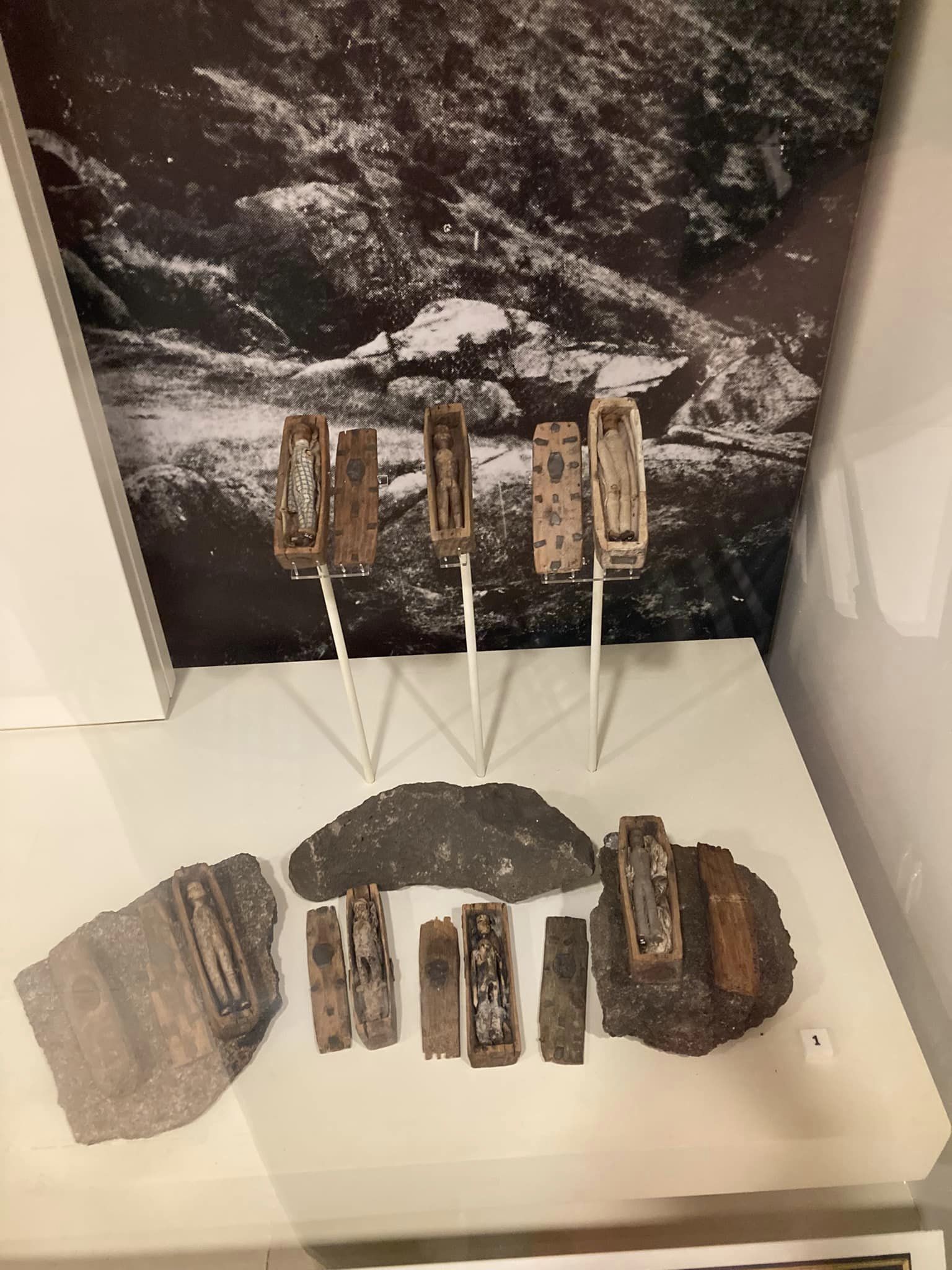The Lady From Ballaculish
Jul. 24th, 2023 09:04 amI did more than eat at the weekend.
The National Museum of Scotland's a lot of fun; the more obviously accessible halls are full of design and engineering, plenty of moving parts and moving children too. At the weekend they overrun the place, enthusiastic and potentially determined to create their own cars/costumes while saving the planet from becoming the Natural History Department. For such a modern looking building it's surprisingly easy to get lost in, which suits me fine. I love labyrinthine nooks that feel like pocketworlds, each of them a door in the wall. Here's the inhabitant of one;

This is the Ballychulish figure,dated to around 600 BC and having sustained a lot of damage after her discovery in 1880. Here's an older photo of her as she was.

She's made of alder, and those are not quite pearls for her eyes, but quartzite stones. She and the wickerwork that surrounded her fell upon a gravel beach before the peat formed around and above her. The expression on her face captured my attention, I find her beautiful. Some say she was a goddess, possibly of fertility, because any female depicted in ancient times must needs be a fertility goddess on account of scholars being unable to imagine other reasons for creating the statue of a woman/girl.
One commentator on a FB page had an interesting take:
"In the sami religion there is a deity/spirit called Leib Olmai which means "the alder man". It seem to have functioned as a guardian spirit of the bear. Alder takes a central role in sami bear ceremonialism and has connotations to magical defense, menstrual blood and the blood of the bear as well. When alder bark is chewed it produces a reddish/brown substance."
Hmm. I suspect she's made of alder wood because it grows near or in watery places, and the sculptor might have been aware that alder is rot resistant. Though the lighting in the museum, the drying out, and the damage together evoke a sense of forlorn mystery, I'm going to say in lieu of facts she does not give me any sinister spine-tingle at all. I find her lovely. My first intuition was that she might have been thrown into a bog as replacement for a human - I can't express how merciful and gentle she felt to me - but that makes no sense because she's on a block so surely she was meant to stand somewhere.
I like her. In fact, if she was standing somewhere very private, I'd even say Hello. But then doubtless some child would come into the room just in time to spot a strange ancient woman whispering to a strange ancient statue; and suddenly I'd be the story.
The National Museum of Scotland's a lot of fun; the more obviously accessible halls are full of design and engineering, plenty of moving parts and moving children too. At the weekend they overrun the place, enthusiastic and potentially determined to create their own cars/costumes while saving the planet from becoming the Natural History Department. For such a modern looking building it's surprisingly easy to get lost in, which suits me fine. I love labyrinthine nooks that feel like pocketworlds, each of them a door in the wall. Here's the inhabitant of one;

This is the Ballychulish figure,dated to around 600 BC and having sustained a lot of damage after her discovery in 1880. Here's an older photo of her as she was.

She's made of alder, and those are not quite pearls for her eyes, but quartzite stones. She and the wickerwork that surrounded her fell upon a gravel beach before the peat formed around and above her. The expression on her face captured my attention, I find her beautiful. Some say she was a goddess, possibly of fertility, because any female depicted in ancient times must needs be a fertility goddess on account of scholars being unable to imagine other reasons for creating the statue of a woman/girl.
One commentator on a FB page had an interesting take:
"In the sami religion there is a deity/spirit called Leib Olmai which means "the alder man". It seem to have functioned as a guardian spirit of the bear. Alder takes a central role in sami bear ceremonialism and has connotations to magical defense, menstrual blood and the blood of the bear as well. When alder bark is chewed it produces a reddish/brown substance."
Hmm. I suspect she's made of alder wood because it grows near or in watery places, and the sculptor might have been aware that alder is rot resistant. Though the lighting in the museum, the drying out, and the damage together evoke a sense of forlorn mystery, I'm going to say in lieu of facts she does not give me any sinister spine-tingle at all. I find her lovely. My first intuition was that she might have been thrown into a bog as replacement for a human - I can't express how merciful and gentle she felt to me - but that makes no sense because she's on a block so surely she was meant to stand somewhere.
I like her. In fact, if she was standing somewhere very private, I'd even say Hello. But then doubtless some child would come into the room just in time to spot a strange ancient woman whispering to a strange ancient statue; and suddenly I'd be the story.
